It’s always been pretty easy to tell the difference between a video game and, well, anything else. Video games were the salt of our childhood – how many of us have memories of racing Mario Kart or pillaging the vases of Hyrule? What about the epic quest to kill Garland, and the adventures of the little blue hedgehog that we’ve all come to know and love? It was pretty easy to discern what was a video game, and what wasn’t, at least for a time, but in 2017 the line is getting a little blurred. What’s happening here is the introduction of virtual worlds, and while there are plenty of arguments as to whether or not they are games, I have a pretty clear stance on the matter: they’re not.
Virtual Worlds - Why Are They Different from Games?
The definition of a video game seems to be pretty clear: it’s something that you load up on your computer or console and you interact with. In order for something to be a game, however, it needs to have an objective, even if Merriam-Webster doesn’t quite agree with me. World of Warcraft has an objective, though admittedly, that objective is a bit of a moving target. Final Fantasy 14 has an objective. Ultima Online even had an objective, so when you move into the territory of games like Second Life, and you see that they do not have a clear objective, it starts to get confusing. You play a character, don’t you? You move around on the screen, you interact with the world, so why is it not a game? I would submit that if you consider those attributes to be indicative of a game, then your entire life is a game, though whose to say that isn’t the truth? Metaphysical thoughts aside, there are now several virtual worlds that do not quite fall into the category of a ‘game,’ by any stretch of the imagination, and we’re going to look at a few of them.
Active Worlds
Today, ActiveWorlds looks a bit primitive, and if we’re going to be perfectly honest, it’s on it’s last legs. The place is a graveyard, but back in 1995, when it was first created, it really was a thing of beauty. In fact, the ActiveWorlds website refers to itself as ‘The Home of 3D Internet.” This tagline alone should give you some insight into the way we viewed the web back in the early days of home computing. We envisioned the internet as a place where we could get together and socialize from the comfort of our own basements, and at that time, most of us could scarcely imagine what the internet would become.
We’ve gone from the days of scrolling IRC chats to a new age where we slay dragons and drink in virtual taverns. I’m not complaining, it’s just interesting to see where we’ve ended up. Now, getting back to 1995, we saw the creation of AlphaWorld, which has undergone several revisions over the years and finally becoming ActiveWorlds on June 28, 1995. Unlike most games, ActiveWorlds was a world created completely by its users, allowing for maximum creativity and a social experience like no other. To its credit, it’s been alive for the last twenty years, and it doesn’t show much evidence of disappearing – yet. It should be noted that ActiveWorlds took on the form of a web browser, rather than a game client, going so far in the 2000’s to emulate Netscape Navigator.
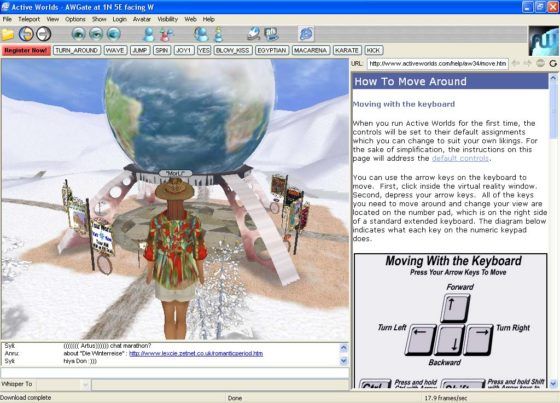 Active Worlds in the Early 2000's
Active Worlds in the Early 2000's
Second Life
Second Life was created by Linden Lab back in 2003, and as of 2013 the platform had one million regular users. Of course, it had more registered users than regular users, and pretty much everyone in the world had at least one alt account. I had about ten; don’t tell anyone. Second Life has evolved significantly over the last decade, but like many games out there, it has never been too AMD friendly. I would know, I’ve been an AMD user for most of my life, but that hasn’t stopped me from logging in since 2006.
Like most virtual worlds, Second Life uses server clusters for each area, but everyone can communicate and interact within the same world. To give you an example, imagine that all of the World of Warcraft servers were laid out in a grid and you could actually walk between them. That’s exactly what Second Life is like, but in each world the user is permitted to build whatever they want so long as they have rights to the land. Speaking of land rights, the fee for a sim in Second Life is a bit steep, costing more than a thousand dollars for initial purchase and several hundred dollars per month after that to maintain. On the upshot, however, in-game currency can be converted to US Dollars. If you’re savvy enough, you could buy some land, rent it out to tenants, and make some very real money being a virtual landlord.
[caption id="attachment_77651" align="aligncenter" width="560"]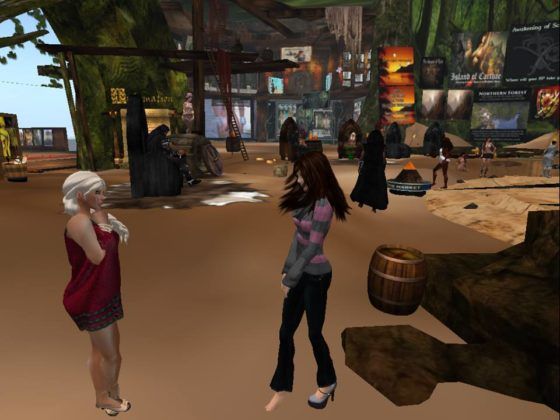 Hanging out in Second Life[/caption]
Hanging out in Second Life[/caption]
While you can use the in-game scripting (LSL) to create games (virtually anything you can imagine), Linden Labs is adamant in the belief that the world isn’t a game as there is no set objective and no manufactured conflict.
Blue Mars
I can’t help but look back and remember the hype surrounding this one. Second Life was the big thing at the time, but for being as big as it was, it really had its fair share of flaws. Those flaws mainly centered around the program actually working as intended. Blue Mars was an interesting project, started in late 2009 and running on Cry Engine 2 rather than a proprietary engine. The fact that it was running on an already stable engine brought with it many possibilities, but the building process was a little more restricted, and it required much higher specs to run effectively.
The bottom line is that the average virtual world user doesn’t really have a gaming rig, and that might have contributed to us not seeing much of Blue Mars presently. Still, like Second Life, you could earn money and convert the virtual currency into real currency. You still have an opportunity to turn a profit, which might be a great reason to visit this world. Though Blue Mars’ environments started off a bit random, it now takes place in the year 2177 on a terraformed mars.
[caption id="attachment_77652" align="aligncenter" width="500"] Early Photo from Blue Mars[/caption]
Early Photo from Blue Mars[/caption]
There!
There are many virtual worlds out there, but one that many people forget, is literally called There! This one actually started in July of 2001, meaning it existed around the same time as many of the others. It’s had a rocky existence, and the one thing it really suffers from is a lack of content creation. It actually closed down for a short period in 2010 and re-opened in 2011. It has enough followers to stay afloat, but full features do require a monthly subscription fee.
[caption id="attachment_77653" align="aligncenter" width="560"]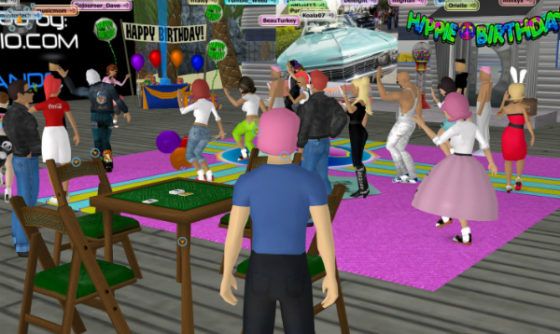 Party over There[/caption]
Party over There[/caption]
Virtual Paradise
This one is a little different and I’m going to be expanding on this one a bit more than the others, primarily because I’m surprised it exists. Virtual Paradise is a virtual world, very similar to ActiveWorlds created by ‘Edwin,’ but the most interesting thing about it is that it is not created or maintained by a corporate entity. In spite of that it has a pretty decent user base, even if it is missing a few key features. This hearkens back to the days of ‘Palaces,’ a 2D virtual word that was like a slightly more advanced chatroom. The interesting thing about Virtual Paradise, however, is that it brings to the table 3D graphics, the ability to build your own structures, and as of late, it even has fully animated avatars. So what we have here is a completely privatized virtual world with a decent user base. I had the opportunity to speak with one of the developers and received some pretty good information on how it is run, and what features we can expect in the future:
***“*It's very decentralized. Edwin is basically god, but the governance, rules, etc. are determined by the majority community basically in an extreme way, and generally Edwin would really be the only single individual to be able to change anything regarding that in an instant, but he takes a hard neutral stance on a LOT of stuff except blatantly obvious content.
I assume you're aware of the community and it's former ties to the AW community (VP is inspired by AW a lot while taking some elements of SL's building department). I can't speak as to what upcoming features are being made by Edwin, and that's probably an area you'll have to get in touch with him about, but VP is essentially a well-maintained and developed cousin of AW. If there are major changes, it'd probably be towards the SDK or new scripting commands. Some of the newer building elements had came about when people like GSK moved over from AW to VP to work on his Aurora project, which will be used for his streamed game shows.
A lot of VP's success is structured heavily around its community, and it has to be like that especially since it's dipping itself in borders between a sandbox and a MMO. It's why it's been able to "compete" with platforms like AW for their own users as well as attract e-celebs like Vinesauce to at least give it a look. The two things that keep VP going as a platform: you can really create a lot of high-quality, detailed shit, also the community around it.
There is a lot that needs to be done with it, but it is insane what it's been able to do in it's current form. It's enough to really trigger (i hate using that word) the AW population because a lot of AW's better people that had produced a lot of content for it, tend to move over here once they get fed-up with the autocratic system that AW has with it's community leaders and AWI.”
Bottom line here: if you’ve ever wanted to sit on the ground floor of an MMORPG or a virtual world, this is probably where you want to be.
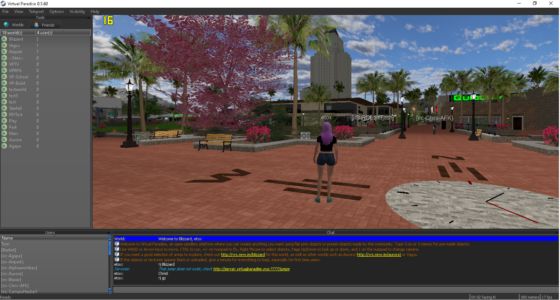
The Sandbox Conundrum
I guess the point I’m trying to make is that virtual worlds aren’t new by any stretch of the imagination, but they are definitely an area of the MMO sea that shifts a lot. Right now, at least as far as I’ve been seeing, the world of sandbox games is starting to shift. Sure, we’re going to continue having games like Second Life and Blue Mars, but people still tend to want the MMO experience, which is where sandbox style games come into play. You want the full medieval experience, really, so that you can fight dragons or build a castle, but you want the world to be your own.
Let’s talk seriously for a moment: the biggest problems with MMORPGs is that while they do give you the opportunity to live in a world and do essentially whatever you want, you still have to contend with the fact that most of them are on rails and only give the illusion of freedom. Granted, it’s a pretty good illusion, but an illusion nonetheless. So, when it comes right down to it, people want freedom. They want the opportunity to live their own life inside a game that doesn’t dictate where they should go. In World of Warcraft, you can technically do whatever you want, but if you don’t follow the progression then you aren’t going to catch up with your friends, you won’t have the best gear, and you won’t be playing the content that you paid for.
No matter what, that’s a bit of pressure that will always be there, a nagging feeling in the back of your head. Kill Garrosh or work on your herbalism? Hmm. Now before anyone comes in and starts correcting me, yes, I am aware that you can spend the entire of your in-game life leveling herbalism in the Pandaren starting zone. So, for that reason I’m just going to give a shout out to ‘Double Agent’ here. In any case, people want to live another life, but they don’t want to be told how to live it. Take games like ‘Life is Feudal’ or ‘Wurm Online’ as your examples. They’re definitely a sandbox game, they don’t have a set objective, but they are an exercise in community building, which is why so many people are turning to them.
A Social Experience
So, finally, here’s the million dollar question: why do so many people feel the need to turn to virtual worlds when they could just kill some time in World of Warcraft? I mentioned above that it’s the need to sort of carve out your own destiny, but I think there is a lot more to it than that. Sure, virtual worlds are fun to explore, but at this point in gaming evolution I think we’ve already been there and done that. Honestly, we’re here, in these sandbox games, to do the things that we simply cannot in real life. What is it that you want to do? Do you want to drive a nice car? Do you want to live in a fancy house? Do you want to be someone else? It has to be something, without a doubt, and that ‘something’ can probably be achieved in a virtual world.
One of the coolest things I’ve come across in my research of virtual worlds over the last decade is the fact that disabled people can make use of them, and it’s especially cool for them if they’re house-bound. Imagine a child, for example, who is trapped in a wheelchair and may never experience the feeling of walking, or even basic normalcy. Now, imagine that they discover a virtual world, and suddenly they have the ability to walk, to run, or even fly. On top of that, they can interact with others and make friends without being judged on their disability because in the virtual world you can literally be anyone you want. Now that’s a power that you simply cannot buy in the real world.
The Next Step for Virtual Worlds
Now we ask the most important question of all: what’s the next step for virtual worlds? To be honest, I think we’ve gone as far as we can with the Second Life model; if you can name it, we’ve been there and done it. We’ve recreated real world locations, we’ve gone to fantasy worlds, we’ve roleplayed our hearts out, and we’ve all done it in front of our computer screens. They can bring on the Blue Mars clones and Second Life wannabes, but at this point they’re just sloppy seconds. If technology wasn't finally catching up to what the consumer wanted then we’d be in a bit of a bind, to be perfectly honest. Virtual Reality would finally become stale and quite honestly, we wouldn’t want to spend that much time in it. Linden Labs is stepping up to fill the gap, however, and they’re doing it in a spectacular way.
[caption id="attachment_77655" align="aligncenter" width="560"]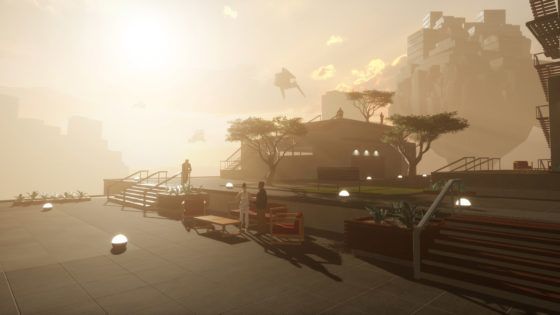 Sansar - The Future of Virtual Worlds[/caption]
Sansar - The Future of Virtual Worlds[/caption]
Sansar is Linden Lab’s next big foray into virtual worlds, and it promises to be a complete knockout. So, what’s happening here exactly? Well, first of all, Linden Lab has been quick to emphasize that Sansar will NOT be Second Life 2. It will be more of a platform than a world, but most importantly it will encourage the use of virtual reality. That’s right, we’re talking about the HTC VIVE or the Oculus Rift, either of which can provide a full immersion experience. Imagine being able to completely detach yourself from the outside world and dive into a brand new world geared toward user creation. If you are an avid user of Second Life then you know that for a time it did in fact have support for Oculus Rift, but now it seems that Linden Lab is pouring its efforts into Sansar. As we move further into 2017, you can be rest assured that this will probably be just one of many projects undertaken to bring virtual worlds into virtual reality.
Where to Start With Virtual Worlds
If you’re reading this, and the first thing that crosses your mind is “I want to get into virtual worlds” then I definitely can’t fault you for that. Becoming another person, even if only for a little while, is extremely appealing, and there are plenty of options out there, but you probably don’t quite know where to start. Truth be told, with ActiveWorlds dead, Second Life is without a doubt, one of the best places for a beginner to start. Its platform isn’t going anywhere, anytime soon, and there are plenty of tutorials out there to help you to get started. Heck, one of the tutorials is even inside the game, so you won’t be left out in the cold.
The most important piece of advice that I can give you, however, is to make sure that you choose your virtual world carefully because once you dive in, you’ll probably be spending a good portion of your life building, exploring, and interacting with the other users. That is true, unless you’re in ActiveWorlds, of course. There’s no one left in ActiveWorlds, after all. If you do choose to take your foray into second life, however, keep in mind that support is a bit barebones these days as the Second Life Mentor program has been discontinued, as has the live Linden chat that existed back in the old days. Still, it’s a pretty fun experience, and you’ll meet a lot of interesting people.
Virtual worlds have come a long way, and no one can deny that. From Alpha World all the way to Sansar, we’ve seen some serious changes and some interesting developments. Virtual worlds aren’t for everyone, not by any stretch of the imagination, but they give you the ability to learn more about yourself along the way. I know I learned a lot during my ten years in Second Life, so what will you learn?